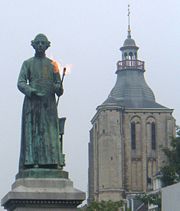
Jean-Pierre Minckelers
Encyclopedia

Maastricht
Maastricht is situated on both sides of the Meuse river in the south-eastern part of the Netherlands, on the Belgian border and near the German border...
, the Netherlands, 1748; d. there 4 July 1824) was an inventor of illuminating gas.
At the age of sixteen, in 1764, he went to the Catholic University of Leuven
Catholic University of Leuven
The Catholic University of Leuven, or of Louvain, was the largest, oldest and most prominent university in Belgium. The university was founded in 1425 as the University of Leuven by John IV, Duke of Brabant and approved by a Papal bull by Pope Martin V.During France's occupation of Belgium in the...
(French: Louvain), where he studied theology and philosophy at the Collegium Falconis, in which he became professor of natural philosophy in 1772.
At this time the question of aerostat
Aerostat
An aerostat is a craft that remains aloft primarily through the use of buoyant lighter than air gases, which impart lift to a vehicle with nearly the same overall density as air. Aerostats include free balloons, airships, and moored balloons...
s and Montgolfier
Montgolfier brothers
Joseph-Michel Montgolfier and Jacques-Étienne Montgolfier were the inventors of the montgolfière-style hot air balloon, globe aérostatique. The brothers succeeded in launching the first manned ascent, carrying Étienne into the sky...
balloons was occupying the mind of scientists, and Louis Engelbert, 6th Duke of Arenberg
Louis Engelbert, 6th Duke of Arenberg
Louis Engelbert, 6th Duke of Arenberg , nicknamed the blind duke, was between 1778 and 1801 the sixth Duke of Arenberg and 12th Duke of Aarschot...
, a promoter of science and art, engaged a committee to examine into the question of the best gas for balloon purposes. Minckelers was on this committee, and in 1784, after many experiments, published a work entitled Mémoire sur l'air inflammable tiré de différentes substances, rédigé par M. Minkelers, professeur de philosophie au collège du Faucon, université de Louvain (Louvain, 1784). As an appendix to this memoir there was a Table de gravités spécifiques des différentes espèces d'air, by T.F. Thysbaert, a member of the committee.
In his memoir Minckelers tells us how he made his discovery: from the very beginning of his experiments he had had the idea of enclosing oil in the barrel of a gun and heating it in a forge. Under action of the heat the oil dissolved and gave way to a very light gas, having other advantageous qualities. Having proved that oil gas was the best for balloons, Minckelers used it for many balloons which rose rapidly and travelled great distances in the neighbourhood of Leuven
Leuven
Leuven is the capital of the province of Flemish Brabant in the Flemish Region, Belgium...
. As we learn from his pupil von Hulstein, who was in his class in 1785, Minckelers at times used this same gas to light his workshop. Moreover, the drift of his memoir proves clearly that in its inventor's eyes the great combustibility of the gas was one of its leading qualities. When Joseph II
Joseph II, Holy Roman Emperor
Joseph II was Holy Roman Emperor from 1765 to 1790 and ruler of the Habsburg lands from 1780 to 1790. He was the eldest son of Empress Maria Theresa and her husband, Francis I...
, in 1788, transferred the Catholic University of Leuven
Catholic University of Leuven
The Catholic University of Leuven, or of Louvain, was the largest, oldest and most prominent university in Belgium. The university was founded in 1425 as the University of Leuven by John IV, Duke of Brabant and approved by a Papal bull by Pope Martin V.During France's occupation of Belgium in the...
to Brussels
Brussels
Brussels , officially the Brussels Region or Brussels-Capital Region , is the capital of Belgium and the de facto capital of the European Union...
, Minckelers continued as professor, but when it was removed back to Leuven he refused to return. He resigned in 1794 and was appointed professor of physics and chemistry at the Central School of Maastricht.
External links
- Gas in the 1911 Encyclopædia BritannicaEncyclopædia Britannica Eleventh EditionThe Encyclopædia Britannica Eleventh Edition is a 29-volume reference work, an edition of the Encyclopædia Britannica. It was developed during the encyclopaedia's transition from a British to an American publication. Some of its articles were written by the best-known scholars of the time...

